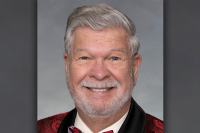Book examines change in rural Appalachia

In the last 75 years, the landscape and the culture of the Appalachian South have undergone enormous change.
Take the town in which I live. Just 16 years ago, this town offered two large grocery stores, a K-Mart, and of course numerous other small, family-owned shops. That was the extent of choices for shoppers. The nearby motels wore that look of seedy disrepair found in so many such establishments built in the 1950s. The town boosted 10 Seven-Elevens, but had few restaurants other than the usual fast food places. By their dress and accents, many of the people in the stores and on the streets were easily identifiable as natives, born and bred in these hills.
Today, the K-Mart is gone, having given way to a shopping area just north of town composed of the usual emporiums: Lowe’s, Walmart, Target, Starbucks, and a couple dozen other shops and establishments, nearly all of them franchises. The population has grown, and is now much more a mix of locals and newcomers, many of them from points north and east. Two new motels sit out by the expressway, large, well tended places that are, like the nearby stores, franchises. Other additions include two health clubs, wineries, Thai and Chinese restaurants, and an independent coffee shop that roasts and brews its own concoctions. The tattooed and pierced crowd abounds and is accepted.
In HomePlace: A Southern Town, A Country Legend, And The Last Days Of A Mountaintop Honky-Tonk (Houghton Mifflin Harcourt, 2018, 251 pages), writer John Lingan takes a long look at the town of Winchester, Virginia, once the cornerstone of America’s apple production, birthplace and home of famed country singer Patsy Cline, and until recently, a city divided between an upper class of old wealth and a lower class composed of country folks and blacks.
In HomePlace, Lingan examines the ways in which the upper Shenandoah Valley, and by extension, our Southern Mountains, have changed over the last seven or eight decades. He details events from the town’s history, the changing race relations, the honors denied Patsy Cline during her short life because so many of her “betters” looked down on her music and way of living. He looks at the invasion of outsiders into Winchester and the surrounding area, and how they have changed that city for better and for worse. He explains how corporations and businesses have both helped and exploited the natives who until World War II lived in close-knit communities centered on agriculture and industries relating to their forests and mineral deposits.
One example: Harry Byrd was a scion of the illustrious Byrd family of Virginia. In 1924, he “helped conceive the first Shenandoah Apple Blossom Festival.” By 1933, his orchards were producing apples from 150,000 trees. He became a millionaire several times over, a U.S. senator, an opponent of racial integration and the owner of a Winchester newspaper. In spite of his power and wealth, however, Lingan tells us “Byrd’s values, his way of life, his political will, and even his personal reputation were seemingly dead as dust by the time he retired.”
Related Items
During his exploration of Winchester and the surrounding area, Lingan returns again and again to Jim McCoy, a local who wrote country music, owned a recording studio for such music, and operated the renowned Troubadour Lounge, “the only twang-and-sawdust roadhouse left in the Virginias.” Jim McCoy was a man devoted to his neighbors and his community, to country music, and to his family. Lingan uses McCoy and the Troubadour as a sort of measuring stick for change. To the end of his life, McCoy, who was the first to put Patsy Cline on the radio, kept to many of his old ways, playing and promoting the music he loved, growing a garden, and remaining true to the hills of home when he could have become a celebrity in Nashville.
Though Winchester continues to celebrate an apple festival, most of the orchards around the city are gone now, changed to apartments or parking lots. The snobbery with which Winchester’s old moneyed families treated Patsy Cline — here I am less confident than Lingan about the severity of this class division — have given way to Patsy Cline commemorations. The changes cited by Lingan in Winchester, like those in Southwestern Virginia, Western North Carolina, or the hills of North Georgia, are real and ongoing. An old way of life, centered on family, land, and custom, has given way to our present age.
Near the end of HomePlace, Lingan writes:
“Factories close or an industry dies, neighborhood businesses lose out to chains, and the people around them are left desperate and isolated. And so we convince ourselves they deserved it: they’re uneducated, or uncouth, or addicted to the wrong kind of drugs … Jim was a left-behind person … He showed me that left-behind people aren’t mere victims. They are trying to make a life in a world where the good old days are gone. What could be more purely American?”
HomePlace is a vivid reminder of what we abandon as we race headlong into the future. Lingan has a heart for people like Patsy Cline, Jim McCoy, and even for Harry Byrd, while at the same time understanding how rapid change affected all of them and continues to work in our own lives.
HomePlace also reminds us that while we may now visit the Internet, send texts and photographs by phone, and select a movie from hundreds presented online, we should also honor the past. We can do so by remembering it, by keeping the good it once offered, its cuisine and music, its emphasis on hard work and independence, its celebration of the eccentric and the local.
Good read, this one.
(Jeff Minick is a writer and teacher. This email address is being protected from spambots. You need JavaScript enabled to view it.)









